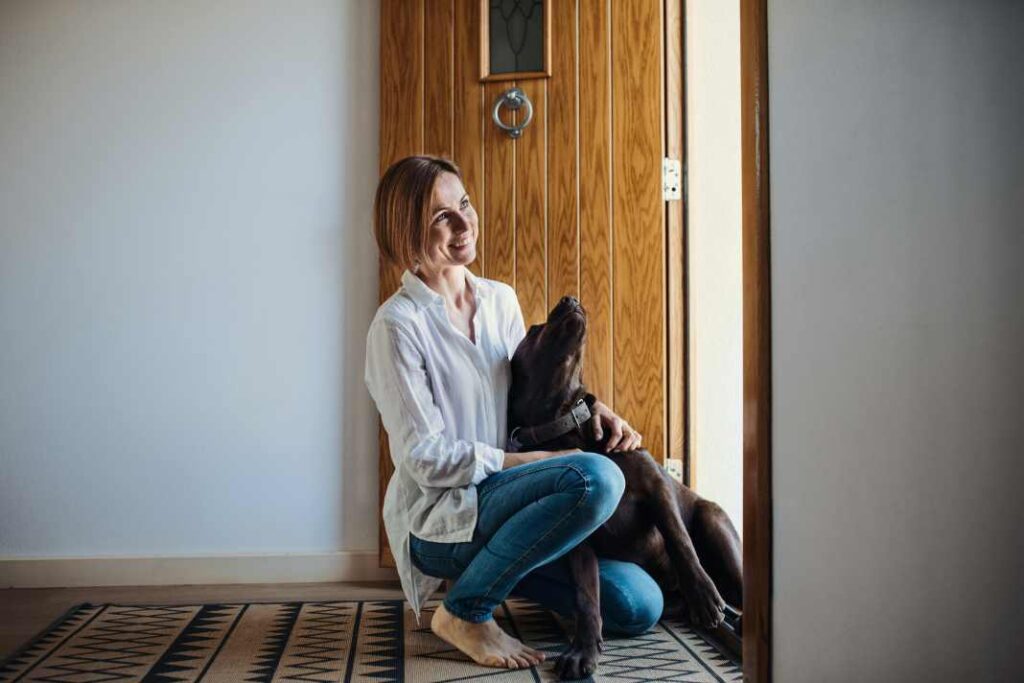Today, I want to talk about how to deal with separation anxiety in dogs using positive reinforcement training techniques, behavioral modifications, and the use of toys and tools to alleviate symptoms, as well as explore treatment options and long-term management strategies before considering rehoming as a last resort option.
Understanding Separation Anxiety in Dogs
What is Separation Anxiety?
Separation anxiety in dogs is a distressing condition that manifests when a pet is separated from their primary caretaker or another animal they have formed a strong bond with. This condition often results in a range of stress-induced behaviors that can significantly affect the dog’s quality of life and the home environment.
It’s essential to recognize that separation anxiety is distinct from other behavioral issues or medical conditions, though they may share similar symptoms, necessitating a careful and informed approach to diagnosis and treatment.
Symptoms of Separation Anxiety
The symptoms of separation anxiety in dogs are varied but typically include excessive barking, indoor accidents, destructive behavior, drooling, pacing, and attempts to escape from the house or confinement.
These behaviors usually start immediately after the departure of the dog’s caretaker or shortly thereafter. Dogs can suffer from separation anxiety, a serious condition causing stress when left alone.
In more severe cases, the distress caused by separation anxiety can lead dogs to injure themselves in their attempts to escape or alleviate their stress. For example, a dog might chew through a door or window frame in a frantic effort to reunite with their owner.
Risk Factors for Separation Anxiety
Certain factors can increase the likelihood of a dog developing separation anxiety. Changes in the household, such as moving to a new home, the arrival of a new family member, or a significant alteration in the family’s routine, can trigger or exacerbate separation-related problems.
Furthermore, puppies that lack early socialization or are separated from their litter at a young age may be more prone to develop separation anxiety. Dogs that exhibit an excessive attachment to their owners, often referred to as “velcro dogs,” are also at a higher risk for experiencing this condition.
Training Techniques and Behavioral Changes
Training to Alleviate Separation Anxiety
Desensitization and counterconditioning are cornerstone techniques in helping dogs overcome separation anxiety. These methods involve gradually acclimating the dog to being alone for increasing periods, combined with positive reinforcement to change the dog’s negative association with separation into a positive or neutral one.
Establishing a predictable pre-departure routine can also significantly reduce a dog’s anxiety by removing the uncertainty surrounding their owner’s departure.
Behavioral Modifications
Behavioral modifications aim to teach the dog that being alone is not only safe but can also be enjoyable. For instance, providing the dog with a special treat or toy that they only receive when alone can help create a positive association with solitude.
Additionally, implementing gradual departures and arrivals can further reinforce the understanding that separations are temporary and not a cause for panic.
Using Toys and Tools to Alleviate Symptoms
Several products on the market are designed to ease separation anxiety in dogs. Adaptil diffusers emit calming pheromones that can help soothe an anxious dog.
Creating a comfortable, den-like space with soft bedding and perhaps even soothing music can offer a secure retreat for a dog feeling stressed.
Interactive camera systems allow owners to monitor and interact with their dogs remotely, providing reassurance and reducing anxiety during separations.
Treatment Options and Management

Immediate Solutions
Addressing separation anxiety often begins with a visit to the veterinarian to rule out any medical issues that could be contributing to the dog’s anxious behavior. A gradual departure desensitization program can be an effective next step, helping the dog become accustomed to being alone for longer periods without distress. Positive reinforcement techniques, such as rewarding calm behavior, are vital in modifying the dog’s response to being left alone.
Long-Term Management
For long-term management, establishing a predictable daily routine for the dog, including regular exercise, playtime, and training sessions, is crucial in reducing overall anxiety levels.
Working with a certified professional dog trainer or behaviorist can be invaluable in developing a customized behavior modification plan tailored to the dog’s specific needs. Monitoring the dog’s progress and adjusting the treatment plan as necessary are key steps in successfully managing separation anxiety.
Rehoming Considerations
Rehoming a dog with severe and unmanageable separation anxiety should be considered a last resort. Before taking this step, efforts should be made to find a suitable environment for the dog where their specific needs can be met, such as a home with experienced owners or a specialized rescue organization.
Full disclosure of the dog’s condition to potential adopters is essential to ensure they are prepared to provide the necessary support and understanding.
Related Articles:
Building a Confident Companion: Socialization Tips for Your Growing Puppy




